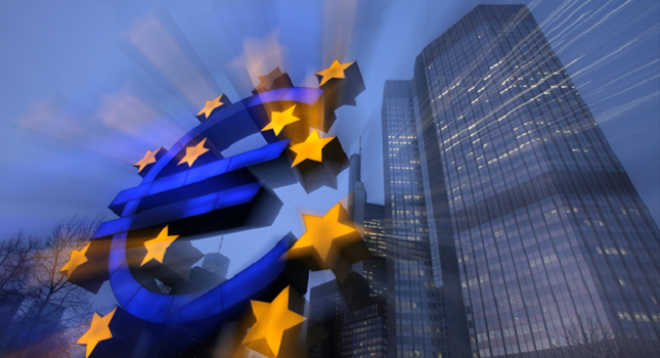Advertisement
Advertisement
EUR/USD Daily Technical Analysis for December 15, 2017
By:
ECB Upgrades Growth but Does Not Discuss the End of QE
The ECB headlined Thursday’s data release with an unchanged policy and little news on when the ECB will end QE. Economic data was upgraded, but inflation remains subdued, which gives a green light to riskier assets. European PMI’s hit a multi-year high, and the SNB also had no change to its monetary policy.
Technicals
The EUR/USD edged lower following the dovish ECB commentary, edging back to support near the 10-day moving average at 1.1808. Resistance on the currency pair is seen near the November highs at 1.1961. The exchange rate is trading sideways, and negative momentum has decelerated. The MACD (moving average convergence divergence) histogram is printing in the black with a flat trajectory which reflects consolidation.
The ECB Left Rates Unchanged
The European Central bank left monetary policy and guidance unchanged, while confirming their quantitative easing program schedule of 30 billion Euros of asset purchases from January to September next year or beyond, if necessary. So, there is still no commitment to an end date for QE and the statement also re-affirmed that interest rates will “remain at their present levels for an extended period, and well past the horizon of the net asset purchases”, which suggests rates hikes won’t be on the agenda until 2019 at the earliest. Furthermore, maturing assets will be reinvested until well after the end of net asset purchases, so a reduction of QE holdings won’t be an issue until then either.
ECB lifts growth and inflation forecasts
ECB sees strong pace of economic expansion and significant improvement in growth outlook, suggest an improvement in the inflation outlook, but at the same time inflation remains low and an “ample degree of stimulus is still needed”. So as expected the ECB acknowledges a stronger than expected growth environment, but Draghi still defends his expansionary policy by pointing to still low domestic price pressures. The new growth forecasts see growth at 2.4% this year, 2.3% next year, 1.9% in 2019 and 1.7% in 2020, which is a clear upward revisions worth 0.5% points for 2019, 0.2% for this year and 2019. Regarding inflation Draghi actually said that underlying inflation is expected to rise gradually also thanks to the ECB’s expansionary policy and the new inflation outlook sees headline rates at 1.4% next year, 1.5% in 2019 and at 1.7% in 2020. Only the 2018 forecast has been revised up and that thanks to energy and food prices and with the 2020 rate still slightly below the ECB’s objective.
Eurozone PMIs end 2017 at Multi-Year Highs
All readings unexpectedly improved again, with the manufacturing PMI reaching a record high of 60.6 and the services reading an 80 month high of 56.5, bringing the composite to 58.0, the highest in 82 months. Manufacturing orders jumped at the highest rate since April 2000 and services orders growth was the joint highest in over a decade according to Markit, with buoyant job creation as companies boosted capacity. A picture of a very strong broad based recovery amid equally broad based demand growth.
The SNB Left Policy Unchanged
The SNB left policy unchanged as expected, noting that while the Swiss franc weakened further since the last policy meeting and the “overvaluation has continued to decrease”, the “franc remains highly valued” and the development is still fragile. “Therefore, despite the easing of the situation, the negative interest rate and the SNB’s willingness to intervene in the foreign exchange market as necessary remain essential”.
Italian November HICP Inflation Moved Higher
Italian Nov HICP inflation was confirmed at 1.1% year over year in line with the preliminary number and unchanged from October. The national rate actually fell back to 0.9% from 1.0%. The Italian HICP rate remains far below the ECB’s objective, but also below the Eurozone average, reflecting a still sluggish economy and high unemployment. Italy so far hasn’t made much use of the window of opportunity created by the ECB’s very accommodative policy that has reduced the burden of high levels of private and public sector debt and with the upcoming election threatening to further disrupt an already fragile political landscape in the Eurozone’s third largest economy, the country is likely to continue to underperform, adding to Draghi’s difficulties.
French Inflation Was Buoyed by Energy
French November HICP inflation was unexpectedly revised down to 1.2% year over year from 1.3% year over year reported initially, leaving the headline rate unchanged from October. As in other Eurozone countries energy price inflation accelerated in November, with the annual rate rising to 5.4% year over year from 4.8% year over year. However, prices for manufactured products continue to decline compared to the same month last year and the annual rise in transport costs actually decelerated in November, to just 1.0% year over year from 1.5% year over year despite the pick up in energy prices. So while headline rates ticked higher elsewhere in the Eurozone, in France, the HICP rate remains below the average and far below the ECB’s objective.
About the Author
David Beckerauthor
David Becker focuses his attention on various consulting and portfolio management activities at Fortuity LLC, where he currently provides oversight for a multimillion-dollar portfolio consisting of commodities, debt, equities, real estate, and more.
Did you find this article useful?
Latest news and analysis
Advertisement
